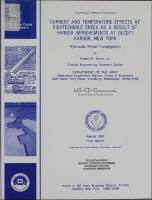Please use this identifier to cite or link to this item:
https://hdl.handle.net/11681/12448| Title: | Current and temperature effects at Eighteenmile Creek as a result of harbor improvements at Olcott Harbor, New York : hydraulic model investigation |
| Authors: | United States. Army. Corps of Engineers. Buffalo District Bottin, Robert R. |
| Keywords: | Creek currents Harbors New York Creek temperature Hydraulic models Eighteenmile Creek, New York Olcott Harbor, New York Stream measurements Hydraulic models |
| Publisher: | Coastal Engineering Research Center (U.S.) Engineer Research and Development Center (U.S.) |
| Series/Report no.: | Technical report (U.S. Army Engineer Waterways Experiment Station) ; CERC-90-3. |
| Description: | Technical Report Abstract: A 1:60-scale (undistorted) hydraulic model of Olcott Harbor, NY, was used to determine the effects of proposed improvements on creek temperatures and currents at Eighteenmile Creek as they entered Lake Ontario. The model (originally used to develop the optimum improvements) reproduced approximately 3,300 and 3,600 ft of the New York shoreline on the east and west sides of the harbor, respectively, about 3,000 ft of the lower reaches of Eighteenmile Creek, and sufficient offshore bathymetry in Lake Ontario to permit generation of the required test waves. Improvements consisted of the installation of rubble-mound breakwaters and channel dredging. An 80-ft-long unidirectional, spectral wave generator and a reservoir of heated water were utilized in model operation. Prototype data were obtained at Eighteenmile Creek during the spring and fall seasons of 1989. Tests then were conducted to verify the performance of the model for existing conditions, and finally, the improvement plan was tested to determine its impact on temperature and current patterns. It was concluded that trends in the model (temperatures, direction of creek plume, etc.) followed trends established in the prototype for existing conditions. With the improvement plan installed, the creek currents and temperature differences varied only slightly in the localized area of the creek mouth, and, on a regional basis, the movement of creek currents after entering the lake was similar to existing conditions. Test results, in general, indicated that the improvement plan will have minimal effects on temperatures and/or the movement of creek water into the lake or along the shorelines. |
| Rights: | Approved for public release; distribution is unlimited. |
| URI: | http://hdl.handle.net/11681/12448 |
| Appears in Collections: | Technical Report |
Files in This Item:
| File | Description | Size | Format | |
|---|---|---|---|---|
| TR-CERC-90-3.pdf | 8.06 MB | Adobe PDF |  View/Open |